The $1 notes
Originally decree núm. 2 on 19 February 1915 authorised 500,000 $1 notes. Then on 10 July decree núm. 5 added a further 1,500,000 notes. Finally, decree núm. 18, on 12 January 1916, authorised a futher issue, without specifying the exact amount of $1 notes. However, issues up to 19 July (number 579765) refer to decree núm. 2 whilst later issues (from number 595503) refer to decree núm. 5.
24 February 1915
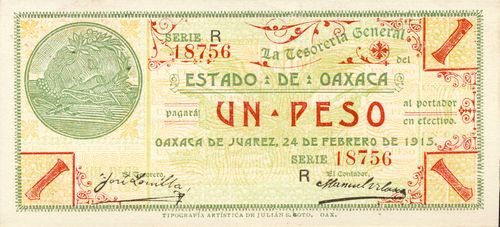
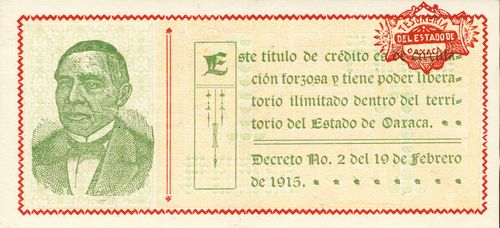
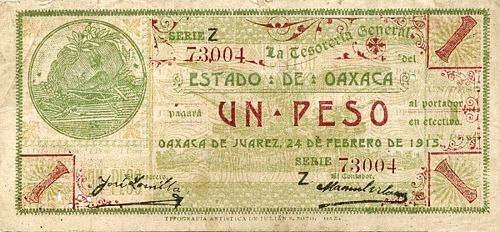
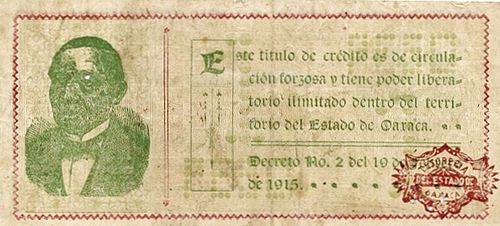 M3372b $1 Estado de Oaxaca
M3372b $1 Estado de Oaxaca
| Series | Triangle | Seal pos. | Portrait type. | Paper | from | to | total number |
total value |
|
| U | ▲ | 1 | 1 | Wove | 05001 | 10000 | 5,000 | 5,000 | includes numbers 05023 to 08878 |
| R | ▲ | 1 | 1 | Wove | 14001 | 19000 | 5,000 | 5,000 | includes numbers 14238 to 18918 |
| Z | ▲ | 3 | 1 | Linen-finish paper | 24001 | includes numbers 24206 to 33237 | |||
| 1 | Wove | includes numbers 33217 to 33346 | |||||||
| 1 | AZTEC BOND | includes numbers 34036 to 74215 | |||||||
| 2 | AZTEC BOND | includes numbers 60965 to 116818 |
The wove paper sometimes shows a watermark "Vilaseca" in double-lined capital letters, plus a coat-of-arms. A doublelined capital "J." is probably part of the same watermark.
The linen-finish paper is a little less thick and sometimes shows a watermark, CAMBRIO BOND in double-line capital letters
The Aztec Bond paper is medium to heavy wove paper that about 40% of the time shows a portion of a watermark AZTEC BOND, reading horizontally or vertically.
The circular seal on the face was changed at about or precisely the same time that the second Juárez portrait was introduced - a matter that requires more research. One can see from the earliest serial number for Portrait Type 2 and the latest for Type I that there was a period where a mixture of notes of both types was being completed with serial numbers.
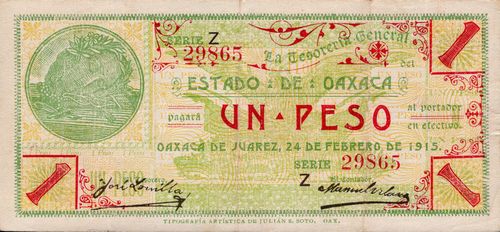 M3372c1 $1 Estado de Oaxaca
M3372c1 $1 Estado de Oaxaca
Some of the 24 February 1915 "Z" Series note have the lower left numeral "1" (on the front of the note) reading up instead of the normal down (head of "1" towards the corner)reported by Clemente Juárez. These range from serial number 26320 to 31242 and seems to be quite scarce even within this range.
20 April 1915
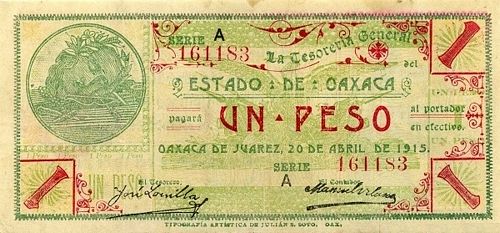
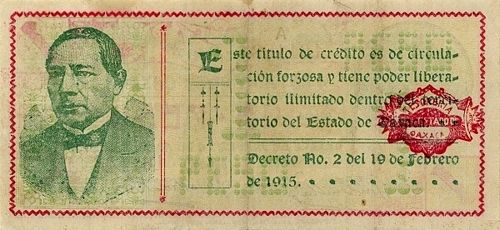 M3372c $1 Estado de Oaxaca
M3372c $1 Estado de Oaxaca
| Series | Triangle | Seal pos. | Portrait type. | Paper | from | to | total number |
total value |
|
| J | ▲ | 1 | 2 | AZTEC BOND | includes numbers 118665 to 146061 | ||||
| A | ▲ | 2 | 2 | AZTEC BOND | includes numbers 155473 to 181865 | ||||
| E | ▲ | 2 | 2 | AZTEC BOND | includes numbers 186522 to 233798 |
Note 233451 shows an error in the lower serial number where the first number was a "3" which was partially erased and overprinted with a "2". A similar renumbering is found on 233798.

26 May 1915
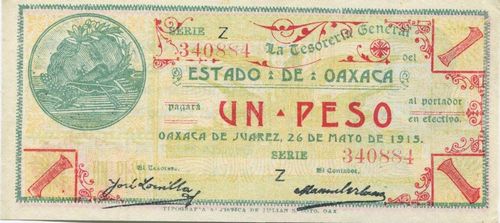
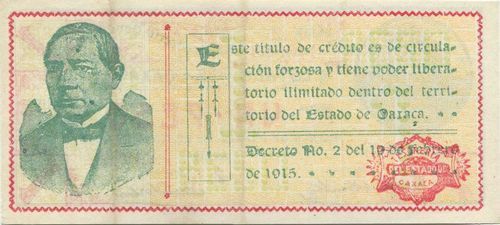 M3372c $1 Estado de Oaxaca
M3372c $1 Estado de Oaxaca
| Series | Triangle | Seal pos. | Portrait type. | Paper | from | to | total number |
total value |
|
| R* | ▲ | 3 | 2 | AZTEC BOND | includes numbers 242935 to 280099 | ||||
| E | ▲ | 1 | 3 | AZTEC BOND | includes numbers 287917 to 308245 | ||||
| ▲ | 1 | 2 | AZTEC BOND | includes numbers 290211 to 325429 | |||||
| Z | ▲ | 3 | 2 | AZTEC BOND | includes numbers 331141 to 350425 |
* There are two types of the R Series, created when the type for the bottom imprint was reset so that accents were eliminated and the spacing between SOTO and OAX. was made smaller. Between roughly serial numbers 259000 and 268000 one can find both types.
My Series R 252325 shows a slight double impression of the red (probably a kiss-print).
During the production of Series E unfinished bills with the second and third Juárez portraits were intermixed before the serial numbers were applied.
26 June 1915
| Series | Triangle | Seal pos. | Portrait type. | Paper | from | to | total number |
total value |
|
| J | ▲ | 7 | 2 | AZTEC BOND | includes numbers 359151 to 388263 | ||||
| ▲ | 7 | 2 | SATURNO plain | includes numbers 390349 to 393876 | |||||
| U | ▲ | 6 | 2 | SATURNO plain | includes numbers 400061 to 419360 | ||||
| ▲ | 6 | 3 | Medium-thick wove | includes numbers 415137 to 431264 | |||||
| ▲ | 6 | 3 | SATURNO plain | includes numbers 419173 to 425665 | |||||
| E | ▲ | 4 | 3 | Medium-thick wove | includes numbers 438988 to 467588 | ||||
| A |
The Medium-thick paper resembles the AZTEC BOND, but I have not seen a watermark.
The SATURNO paper is watermarked with the word imposed on a large image of the planet, with "JA" a bit below. This is quite thick paper, whiter than any so far, somewhat porous and rather rough surfaced. At most, a portion of the watermark is present. Watermarks of just the letters "B" or "E" are also known. They occur on different portions of the same sheet of SATURNO paper.
19 July 1915
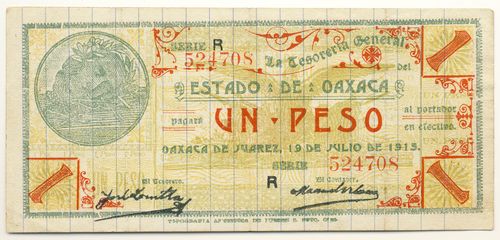
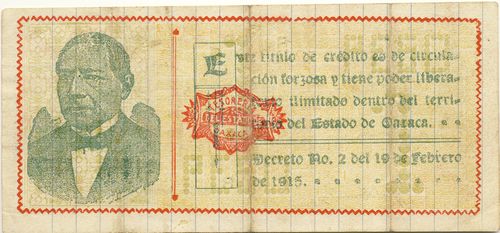 M3372d $1 Estado de Oaxaca
M3372d $1 Estado de Oaxaca
| Series | Triangle | Seal pos. | Portrait type. | Paper | to | from | total number |
total value |
|
| U | ▲ | 9 | 2 | Medium-thick wove | includes number 473730 | ||||
| ▲ | 9 | 2 | SATURNO ledger | includes numbers 474839 to 507464 | |||||
| R | ▲ | 5 | 2 | SATURNO ledger | includes numbers 513575 to 513973 | ||||
| ▼ | 5 | 2 | SATURNO ledger | includes numbers 515980 to 540644 | |||||
| E | ▼ | 1 | 2 | SATURNO ledger | includes numbers 546159 to 579765 |
This Satumo paper is like that seen in the 26 June "U" Series except that it has ledger lines printed on it, bluish lines in one direction, horizontally or vertically, about 7.5 mm apart and crossed occasionally by red lines (sometimes double lines). Ledger lines frequently cover only a portion of the note. The SATURNO watermark is only occasionally seen. A watermark is also sometimes seen which shows a double-line serifed "CA" (smaller than the "B" or "E" sometimes seen which is part of the SATURNO watermark. It appears this "CA" is from a different paper though it resembles the one bearing the SATURNO watermark. Another very fancy emblematic watermark has also been seen, the paper also resembling the SATURNO paper (the "CA" watermark may be from this paper, as well).
10 August 1915
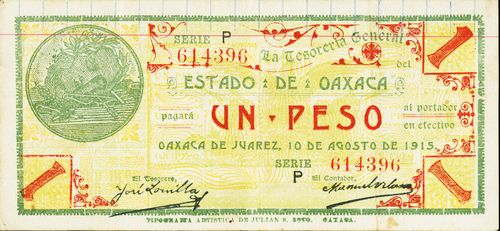
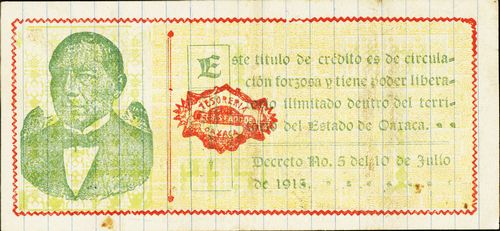 M3372f $1 Estado de Oaxaca
M3372f $1 Estado de Oaxaca

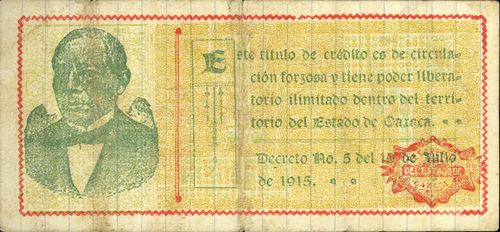 M3372f $1 Estado de Oaxaca
M3372f $1 Estado de Oaxaca
| Series | Triangle | Seal pos. | Portrait type. | Paper | from | to | total number |
total value |
|
| P | ▼ | 8 | 3 | SATURNO ledger | includes numbers 595503 to 644330 | ||||
| Z | ▼ | 3 | 3 | SATURNO ledger | includes numbers 647848 to 654529 | ||||
| ▲ | 3 | 3 | SATURNO ledger | includes numbers 656304 to 696462 |
The key plates were altered with a change in the bottom inscription of the front plate - Oaxaca is spelled out instead of abbreviated. On the back, the decree number and date line has been changed to "Decreto no. 5 de 10 del Julio de 1915". A P series note without serial numbers has been reported.
3 September 1915
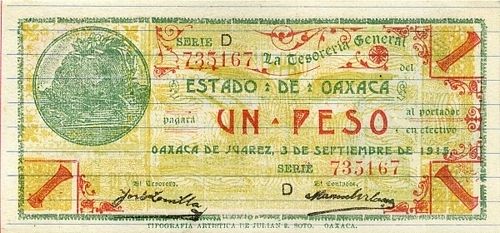
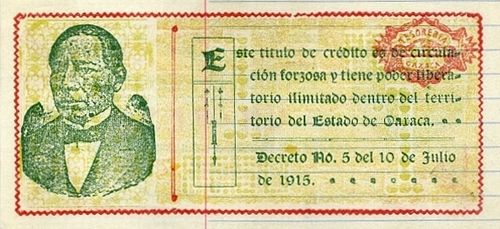 M3372f $1 Estado de Oaxaca
M3372f $1 Estado de Oaxaca
| Series | Triangle | Seal pos. | Portrait type. | Paper | to | from | total number |
total value |
|
| D | ▲ | 1 | 3 | SATURNO ledger | includes numbers 700613 to 749977 | ||||
| ▲ | 1 | 3 | Cream paper, faint lines | includes numbers 745949 to 749230 | |||||
| A | ▲ | 10 | 3 | SATURNO ledger | includes numbers 752241 to 781357 | ||||
| ▲ | 10 | 3 | Cream paper, faint lines | includes numbers 783202 to 801382 | |||||
| I |
The thick, cream-colored paper with faint ledger lines has a different texture than the Satumo paper - not porous and quite smooth. The lines are always vertical and seem to be a greenish gray color.
Series I reportedly exists. I have not seen it.
Within the D Series, sometime in the 720000s serial numbers, the UN PESO lettering was reset so that the letters are slightly further apart and the overall length of the words went from 52 mm. to 53.5 mm. The large numeral ''l''s in the three comers were also switched around. Each of these ''l''s is very slightly different. the most noticeable difference is a tiny break in the left side of the bottom outline of one of them. This "I" is in the lower right comer of the earlier D Series notes but appears in the upper right comer when the type was reset.
24 September 1915
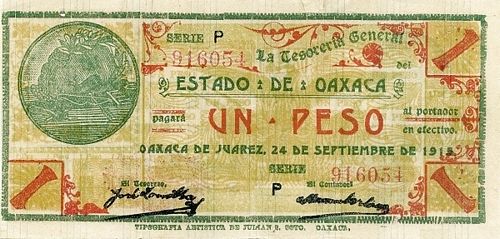
 M3372g $1 Estado de Oaxaca
M3372g $1 Estado de Oaxaca
Over 400,000 1 Peso notes were produced dated 24 September, yet for the specialist this is an exciting date because it offers so much variety.
At least eight issues of 1 peso notes were made bearing the 24 September 1915 date, alternately designated series Z and P. The explanation for this alternation of P and Z series issues is that printings of the 5 pesos (four issues, all Series I) were made in between which required resetting the denomination plate.
24 September I peso notes have been found on no less than 23 different papers. While the less distinctive of these are unlikely to be of interest to most collectors, others are of sufficient interest and scarcity that many will wish to know about them. All so far known, regardless of novelty or degree of scarcity, will be described in the order in which they first occur in the sequence of serial numbers, grouped according to issue (letter series).
| Series | Triangle | Seal pos. | Portrait type. | Paper | from | to | total number |
total value |
|
| Z | ▲ | 6 | 3 | Medium (" WHITEHALL") | includes numbers 811018 to 837145 | ||||
| ▲ | 6 | 3 | Unwmkd with ledger lines | includes numbers 840805 to 869868 | |||||
| ▲ | 6 | 3 | Thick with horizontal black ledger lines | includes numbers 842809 to 858758 | |||||
| ▲ | 6 | 3 | Thick with paired horizontal black ledger lines | includes numbers 862597 to 869878 | |||||
| P | ▲ | 4 | 3 | Thick with paired black lines | includes numbers 881830 to 891842 | ||||
| ▲ | 4 | 3 | Unwatermarked with ledger lines | includes numbers 895945 to 907813 | |||||
| ▲ | 4 | 3 | Staffed vertical narrow-spaced lines | includes numbers 911748 to 914285 | |||||
| ▲ | 4 | 3 | Medium thin paper | includes number 918200 |
Medium-weight, white paper whose weave is somewhat distinct when held to the light. 0.036"-0.038" thick. Sometimes a watermark WHITEHALL can be seen reading either horizontally or vertically. Its letters are doubleline, sans-serif capitals.
The unwatermarked paper has very light gray or slightly blue vertical ledger lines 7.5 mm apart. 0.034"-0.040" thick.
The thick paper has black ledger lines most of which are usually spaced 11 mm apart and run horizontally. Sometimes they are only 10 mm apart with an occasional 16 mm space between two of the lines. Sometimes pairs of lines will be connected by a vertical dotted line. The paper, itself, is rather pulpy and does not show a weave when held to light. The paper seems to have been removed from books because sometimes at the left end of the note there will be a vertical crease and a couple of spindle holes.
The thick paper with paired horizontal black ledger lines alternating 11 mm and 5.5 mm apart is otherwise similar to the previous (3). However, the two are clearly separate papers because of their different places in the serial number sequence. Sometimes at the left end of a note, the horizontal lines will terminate in a vertical line.
Unwatermarked paper, crossed by red lines or occasionally paralleled by double red lines (reminiscent, perhaps, of the layouts seen on the SATURNO paper on the previous series). Warning: these lines can fade or wash out. Found starting Series P(I).
"Staffed vertical narrow-spaced lines" paper has 7.5 mm "bands" comprised of five evenly-spaced lines, each band 11 mm from the next. These lines are quite faint.
Similar to the Unwatermarked, with ledger lines (2) but without the lines.Thickness is 0.030"-0.036". Since ledger lines can fade or wash away identification should be tentative when the paper thickness is greater than 0.034". However, paper 2 has not been found on this issue without additional red lines.
Sometime between serial numbers 851518 and 853793, the UN PESO lettering was reset so that the letters are a little closer together, the overall length of the words going from 53 mm. to 52 mm.
| Series | Triangle | Seal pos. | Portrait type. | Paper | from | to | total number |
total value |
|
| Z | ▲ | 1 | 3 | Thick with black ledger lines | includes number 924242 | ||||
| ▲ | 1 | 3 | Unwatermarked, with ledger lines | includes numbers 931131 to 955860 | |||||
| ▲ | 1 | 3 | Medium-thick with ledger lines | includes numbers 944683 to 954405 | |||||
| ▲ | 1 | 3 | Very thick, white paper with vertical ledger lines | includes number 953090 | |||||
| ▲ | 1 | 3 | Fine horizontally laid | includes numbers 929693 to 962677 | |||||
| ▲ | 1 | 3 | Medium with black ledger lines | includes number 959738 | |||||
| ▲ | 1 | 3 | Medium laid paper | includes numbers 961946 to 962677 | |||||
| ▲ | 1 | 3 | Thin with ledger lines | includes number 963478 | |||||
| P | ▲ | 3 | 3 | Medium laid paper | includes numbers 975154 to 1-011486 | ||||
| ▲ | 3 | 3 | Unwmkd with ledger lines | includes numbers 975549 to 983830 | |||||
| ▲ | 3 | 3 | Medium-thin with ledger lines | includes number 976375 | |||||
| ▲ | 3 | 3 | Thick, pulpy paper with faint ledger lines | includes number 979281 | |||||
| ▲ | 3 | 3 | Medium paper | includes number 980394 | |||||
| ▲ | 3 | 3 | Medium, with black ledger lines | includes numbers 982219 to 988440 | |||||
| ▲ | 3 | 3 | Bluish ("CAMBRIO") | includes numbers 992000 to 1-019190 | |||||
| ▲ | 3 | 3 | Smooth paper with faint ledger lines | includes number 1-010121 |
The Medium-thick paper with ledger lines has faint bluish gray vertical lines spaced IO mm apart (wider apart than on 2) and occasionally crossed by a double line, one red. The paper, itself, is wove, slightly pulpy and varies in thickness from medium to quite thick, 0.045"-0.053".
Very thick paper (0.05 l "-0.052") has vertical ledger lines 7.5 mm apart and resembles (and may actually be) the SATURNO paper of earlier dates, very white and having a somewhat rough surface.
The fine horizontally laid paper is very white, with about 12 laid lines per centimeter. It sometimes shows a fancy watermark. It is rather thick - 0.047"-0.053".
On the Medium paper with black ledger Jines, the lines may be horizontal or vertical, single, doubled or dotted, and may be found on one or both sides of the note.
The laid paper is fairly thin to medium (0.035"-0.045") and sometimes shows the watermark "ORIGINAL I MARIAN PAPER" in double-lined letters. The laid lines are about 8 per centimeter and may be horizontal but are more often vertical. Sometimes very faint ledger lines about 8.5 mm apart can be detected.
The thin paper has vertical ledger lines spaced about 8.5 mm apart. It is white, and its weave is fine and not apparent.
0.025"-0.028".
Note:Unwatermaked ledger paper is the common one for this issue. The others are scarce to very rare.
Thick, pulpy paper with faint ledger Jines has vertical lines 9 mm apart and occasionally crossed by a single line. The recorded example is rather brownish, perhaps due to high acid content. 0.037"
The bluish paper may show a watermark CAMBRIO BOND reading either horizontally or vertically. It has a linen finish. 0.034"-0.036"
Very white, smooth paper 0.043" thick with faint vertical ledger lines 8.75 mm apart. Can show a watermark ("Stat_").
Regarding Medium laid paper (11), this series: known examples are concentrated at three small spans in the indicated range. This is actually a rather scarce paper. Papers 2 and 14 are the common ones for this issue.
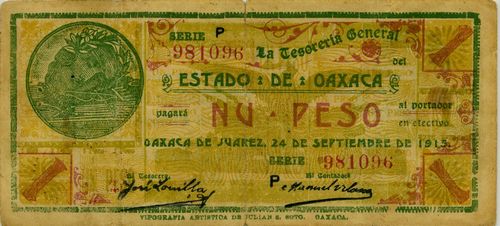
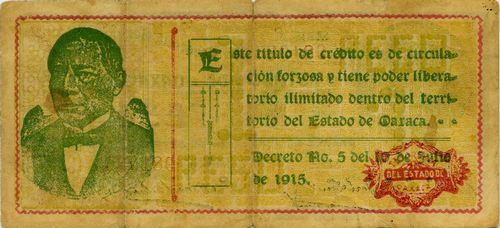 M3372h $1 Estado de Oaxaca
M3372h $1 Estado de Oaxaca
The error "NU" for "UN" occurs in the second P Series (towards, but not at its very beginning) and is extremely rare. Rosovsky stated he knew of only two examples. Serial number 981363 has been recorded from the Rosovsky article's illustration but without mention of which paper it was printed on. Serial number 981096 was in the Ken Tabachnick collection and is on plain wove medium-weight paper. The treasury seal is position 3.
Obviously, the duty plate was reset for this error to have occurred, yet the notes before and after the error show no apparent changes other than very slight differences in how the horizontal and vertical line around the bottom right comer numeral come together (they are a fraction of a millimeter further apart after the error).
Also during the second P Series (sometime after serial number 1-009987) the border was changed from the sawtooth typesetting to the double line, one wavy. The latter border was used for all subsequent series.
| Series | Triangle | Seal pos. | Portrait type. | Paper | from | to | total number |
total value |
|
| Z | ▲ | 1 | 3 | Bluish ("CAMBRIO") | includes numbers 1-037482 to 1-070512 | ||||
| ▲ | 1 | 3 | Medium with faint ledger lines | includes numbers 1-071154 to 1-085430 | |||||
| P | ▲ | 11 | 3 | Medium with faint ledger lines | includes numbers 1-094678 to 1-145122 |
The medium paper's ledger lines are very faint (easily missed, in some cases), vertical and about 8 mm apart. It is
porous and unwaterrnarked, thinner than paper 2 and never has any horizontal or red lines. 0.041 "-0.044" thickness.
| Series | Triangle | Seal pos. | Portrait type. | Paper | from | to | total number |
total value |
|
| Z | ▲ | 2 | 3 | Medium, with faint ledger lines | includes numbers 1-151576 to 1-174616 | ||||
| ▲ | 2 | 3 | Medium-thin with blue ledger lines | includes numbers 1-160810 to 1-161302 | |||||
| ▲ | 2 | 3 | Thick with ledger, quad. lines | includes numbers 1-162428 to 1-185645 | |||||
| ▲ | 2 | 3 | Bluish ("CAMBRIO") | includes numbers 1-163450 to 1-194198 | |||||
| ▲ | 2 | 3 | Medium ("WHITEHALL") | includes numbers 1-168980 to 1-171983 | |||||
| ▲ | 2 | 3 | Thick with ledger, quad. lines, including blue & purple | includes number 1-193795 | |||||
| ▲ | 2 | 3 | Thick with faint ledger lines | includes numbers 1-194793 to 1-198231 | |||||
| P | ▲ | 2 | 3 | Medium, with faint ledger lines | includes numbers 1-211513 to 1-237700 | ||||
| ▲ | 2 | 3 | Thin, soft paper | includes numbers 1-214890 to 1-247620 | |||||
| ▲ | 2 | 3 | Medium-thick with ledger, quad lines | includes number 1-218461 | |||||
| ▲ | 2 | 3 | Thick, plain paper | includes numbers 1-219357 to 1-258205 | |||||
| ▲ | 2 | 3 | Thick with ledger, quad. lines, including blue & purple | includes number 1-218533 | |||||
| ▲ | 2 | 3 | Medium with faint and black ledger lines | includes numbers 1-250666 to 1-251536 | |||||
| ▲ | 2 | 3 | Pulpy laid paper | includes number 1-239579 |
The medium-thin has dark blue vertical lines 8 mm apart and occasionally crossed by r double red or single blue lines - all very obvious. 0.032"
The Thick ledger/quad paper has a faint quadrille pattern which is usually vertically oriented, and vertical red single or double lines at different intervals. 18A: same, except for the presence of some lines which are blue or purple.
The Thick paper is rather soft and porous and has very faint ledger lines 7.5 mm apart. 0.042"
The thin, soft paper is wove. 0.029"-0.033"
Thick and plain ranging in thickness from 0.042" -0.05". This may actually be more than one paper since portions of two seemingly different watermarks have been seen.
The faint ledger lines are vertical. Black lines may be vertical or horizontal, single or double and with varied spacing. Sometimes one line is heavier than the others.
Somewhat thick, pulpy paper whose laid lines are horizontal and rather indistinct, about 8 per centimeter and
crossed by faint lines 24 mm apart.
15 November 1915
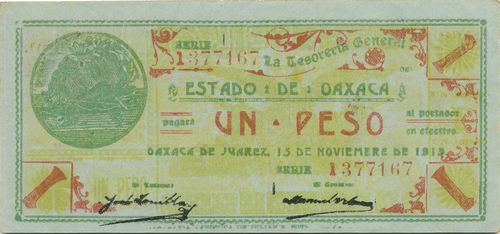
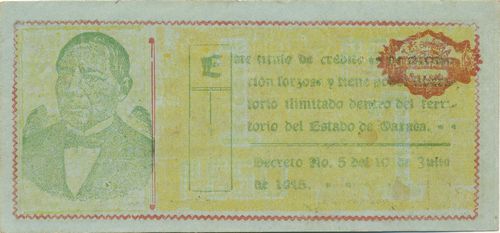
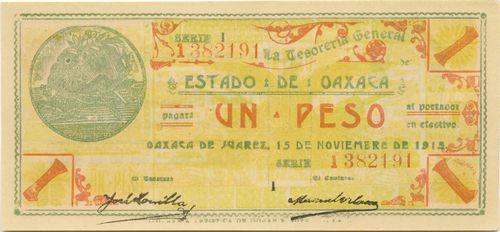
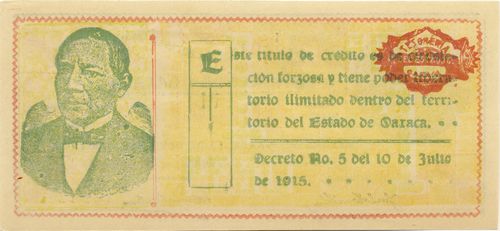 M3372j $1 Estado de Oaxaca
M3372j $1 Estado de Oaxaca
| Series | Triangle | Seal pos. | Portrait type. | Paper | from | to | total number |
total value |
|
| A | ▼ | 4 | 3 | Medium-thin, faint ledger lines | includes numbers 1-261011 to 1-307780 | ||||
| ▲ | 4 | 3 | Medium-thin, faint ledger lines | includes numbers 1-279592 to 1-294420 | |||||
| ▲ | 3 | 3 | Medium-thin, faint ledger lines | includes number 1-283992 | |||||
| D | ▲ | 12 | 3 | Medium-thin, faint ledger lines | includes numbers 1-324973 to 1-329818 | ||||
| I | ▲ | 1 | 3 | Very bluish JONATHAN | includes numbers 1-377167 to 1-378153 | ||||
| ▲ | 1 | 3 | Medium-thin, faint ledger lines | includes numbers 1-378794 to 1-41209 | |||||
| ▼ | 1 | 3 | Medium-thin, faint ledger lines | includes numbers 1-412233 to 1-426400 |
The vertical ledger lines are very difficult to see and often fade out altogether.
The very bluish paper may show the watermark BROTHER JONATHAN BOND, Bond appearing about an inch below the other two words. It appears to be fairly scarce but not rare.
These are the last 1 peso notes - none were produced during 1916.
